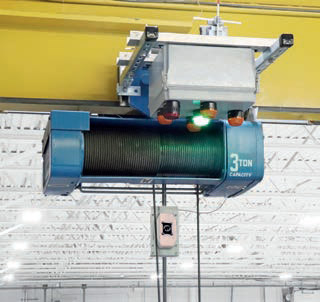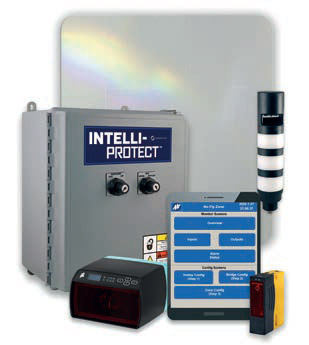Quick and Easy Digitalisation from Columbus Mckinnon
28 August 2020The first element of Columbus McKinnon’s Intelli-Crane suite of digital motion control systems, Intelli-Protect, was introduced earlier this year, with the next—Intelli-Lift— due for launch this month.
While Intelli-Protect can create ‘no-fly zones’ for cranes, Intelli-Lift will prevent side-lifting and side-pulling. One key differential offered by the Intelli-Crane suite is that it can be installed as ‘ready-made automation’, rather than requiring a full custom automation system to be developed. It’s also designed to be extremely user-friendly. These characteristics offer a range of advantages, says Jim Kluck, global product manager for controls and automation at Columbus McKinnon.
“Columbus McKinnon’s Magnetek brand has been offering automation for decades,” says Kluck. “Now, the advancement of user interfaces and software, particularly the development of personal devices such as smartphones, can bring it to the masses. Our customers were looking for opportunities to do more, so we developed Intelli-Crane.
“Larger companies, and those in bigger industries such as metals and paper manufacturing, have come to us to develop automated handling systems. Columbus McKinnon wanted to take automation to everyone, including smaller companies— to provide solutions that everyone can set up and operate, even without PLC programming experience. And for any training requirements, software updates and so forth, customers can come to us.”
“With the retirement of an experienced workforce, there is a need for products that suit the skills of a more technologically driven generation. Plus, now more than ever, companies are having to do more with less. This means workers are being tasked with more work, less specialized job responsibilities, and sometimes have limited training,” says Kluck. “With automated technology, workers have built-in safety features that help make their jobs easier and safer, while enabling easily repeatable processes—all of which help avoid costly downtime.”
The different systems within Intelli- Crane are modular, which is where the ready-made automation concept comes in. Each component has a part number and price and can be built and shipped within two weeks, says Kluck, reducing project lead times by 2–3 months to a year. The degree of pre-engineering also makes the technology economical, as well as being easy to set up: it can be done using a personal device such as an iPad.
The systems are still built to order up to a point, though; customers have flexibility in the design of each system, including the choice of components used. Specific requirements or components can be included through the engineered-to-order process.
Using smart devices to access the Intelli- Crane suite means that programming and troubleshooting can be done from the plant floor, while the hoist is near the roof of the facility—improving safety by eliminating the need to access an elevated control panel.
The Intelli-Protect system also enhances safety, by preventing cranes from travelling over certain areas of the factory floor or colliding with permanent elements of a facility. Outside a protected no-fly zone is a stop zone, and outside that, a slow-down zone.
“It can help the operator if they are moving a large load with reduced visibility,” says Kluck, “or if the operator has a lack of experience or skills.
“The user can configure the dimensions of each zone, as well as adding and removing zones, and can add ‘walls’ over which the crane must travel at a certain height, with an operational area in the middle. The zones can be updated as the plant floor changes, and the system can be disabled temporarily if required, for example, for maintenance.”
All of this is done from the plant floor, as mentioned. “There are two ways of inputting the coordinates of the no-fly zones,” says Kluck. “The ‘Teach’ mode enables the operator to move the crane to the extremities of each zone, which are then logged by the system. The ‘Manual’ mode can be used if the operator knows the dimensions of the areas in question.”
This month, the company launched the next part of the Intelli-Crane suite, called Intelli-Lift. This solution, says Kluck, is designed to prevent side-lifting and side pulling; that is, a lift performed with the hoist not aligned vertically above the load, creating swing which can damage nearby items, as well as potentially damaging the crane and hoist. It also tackles snagging, which is a particular issue in the automotive industry when moving die sets from die field to press, if one of the attached chains does not detach.
The system is integrated into the crane controls and can produce one of two results if an off-center lift is detected.
‘Detection’ won’t inhibit the crane movement, instead it will alert the operator with a visual indicator, whereas ‘Prevention’ stops the crane from lifting the load before the hoist is adjusted to the correct position, either automatically or manually.
An accompanying status light box uses four lights, on the cardinal direction points, to indicate which direction the hoist needs to move to align with the load. A by-pass function—used when, for example, turning or flipping a die set for cleaning, says Kluck—is also indicated by a light when activated, to prevent it from being left on inadvertently, for example, during shift changes.
The Intelli-Protect and Intelli-Lift systems are the first two automated solutions in the Intelli-Crane suite, with further installments planned, including diagnostics and analytics software, and an auto-dispatch system, Intelli-Guide, for moving a crane automatically from point to point.

